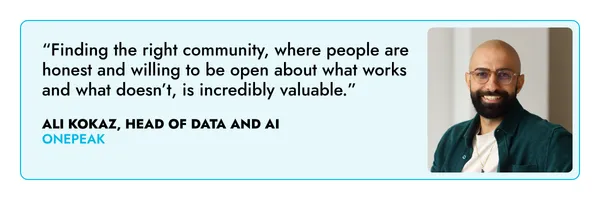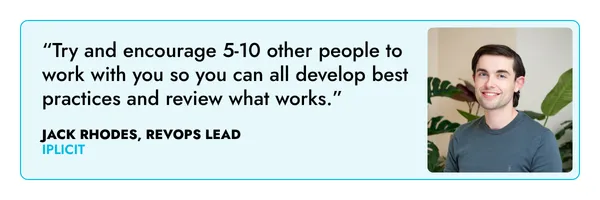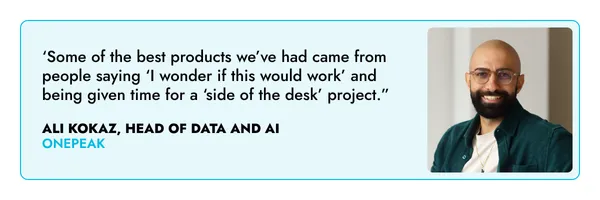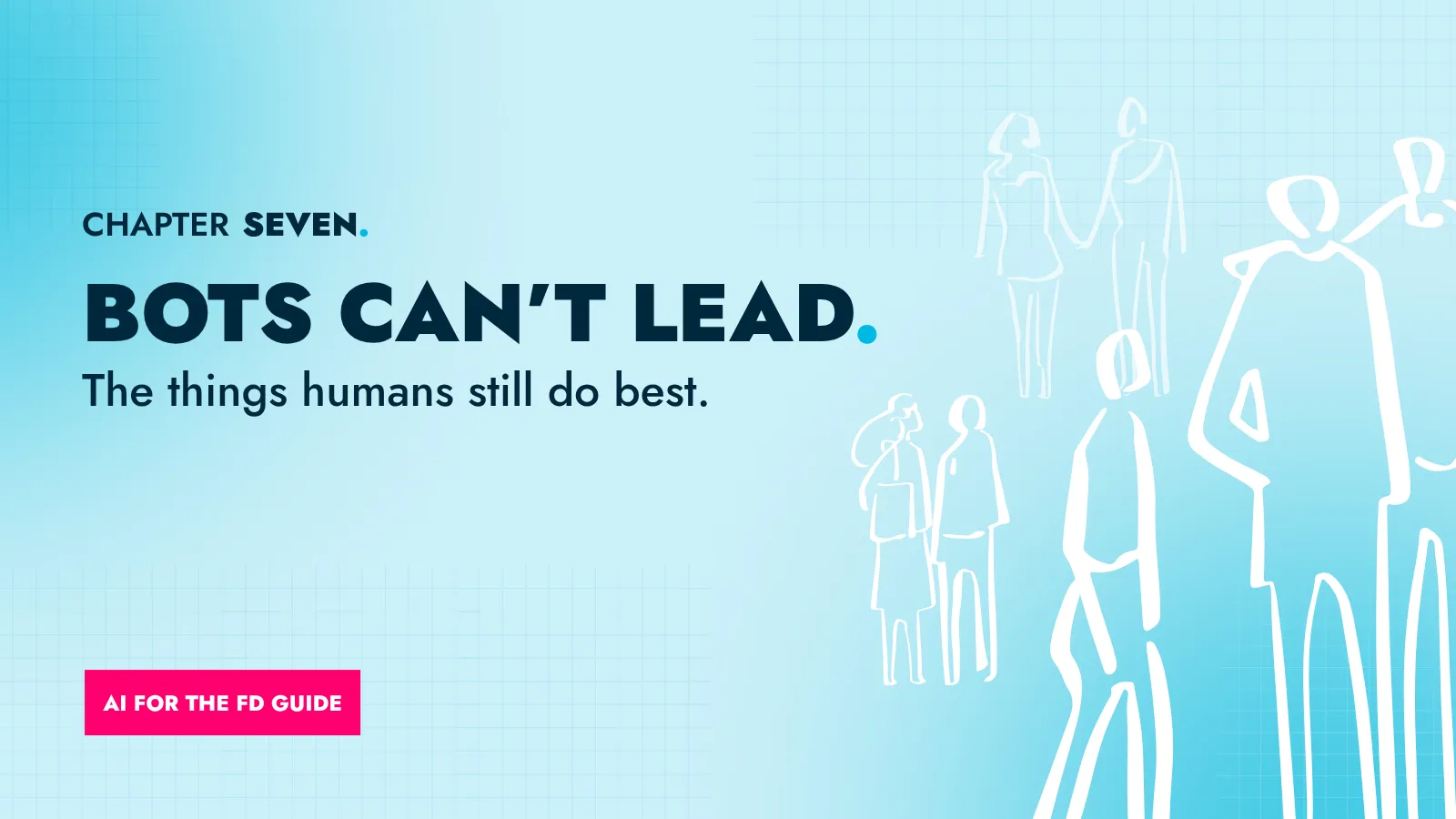Fun with AI: How to experiment safely
Discover practical ways to learn and experiment with AI, even if your organisation is slow to adopt it. From personal projects and peer communities to steering groups and company-wide initiatives, this chapter shows how curiosity and collaboration can unlock real progress.

📘 Definitions #5
Machine learning: A way for computers to learn from data so they can make decisions or predictions without being explicitly told what to do. An example could be forecasting cash flow based on past performance, customer behaviour and market trends – or flagging unusual transactions that could indicate fraud.
Getting up to speed
The world of AI moves so fast that learning enough about it – and then keeping your knowledge up to date – might look impossible.
After all, even the experts who live and breathe this stuff don’t know everything. And these are people who don’t have to concern themselves with doing the bank reconciliation.
The challenge of getting up to speed might look even more daunting if you’re part of an organisation that’s doing little or nothing to encourage AI use. So how do you learn, experiment and keep improving? And how do you encourage wider AI experimentation among your colleagues?
Our interviewees suggested some approaches.
Try this at home

If your workplace is unenthusiastic about AI or just too darned busy for you to devote any time to it, you may have to do your initial learning at home.
“If your organisation isn’t ready for the tech, then I would say you should be doing things on a personal level outside work – even if it’s just reading articles and watching YouTube videos to start with,” says FD Becky Glover.
“You can use it in your personal life too. You might start by saying to an AI tool ‘I’ve got to pack five lunchboxes this week. Give me some ideas for what the kids can eat’.”
Jake Moore, Global Cybersecurity Advisor at ESET, advises: “Just go all in. Go and use it for everything.
“I speak to parents who don't understand their children's homework – well, that's what ChatGPT is there for. It can be your assistant when you are helping your child. Don't give the child access to ChatGPT but that's a really creative way of learning together."
Learn through play
“The best way to start is just to be curious,” says Becky Glover.
“When children are little, at nursery or early school, they’re always taught through play. I always wonder: When did that stop?
“I just love to play with this stuff. A lot of this tech is really hard to break, so as long as you understand enough to be careful with confidential data, you can just learn through playing with ChatGPT.”
Ask AI
AI can help you learn a lot of things – including how to use AI.
“There’s a mass of information out there and so much noise, so honestly I would ask AI,” says podcaster and CEO Indi Tatla.
“AI is a really good resource for this. You can just tell it to teach you how to do something. I’ve learned to prompt it to teach me about a particular subject.”
That doesn’t only have to be about asking AI ad hoc questions. You could tell AI about your role, your job responsibilities and your current level of AI knowledge, then ask it to generate a 90-day learning plan tailored to the number of hours you can allocate each week.
Try different tools and models
The main AI platforms – ChatGPT, Gemini, Claude and so on – each have their strengths.
It can be confusing for a user because a platform like ChatGPT may offer several models at once. Until recently, there was ChatGPT 4.0, O1 Pro, O3 Pro, and a number of other different models all available and all optimised to do different things. Claude and Gemini also have multiple models that are active or tailored to different tasks.
Whilst the vendors have started to simplify things, as in ChatGPT 5.0, it’s worth experimenting to see which model suits your needs best – whether your focus is on creativity, speed, accuracy or technical depth.
“Each model is built differently, trained differently on different data for different purposes and will give you different answers to the same question,” says Daniel Lawrence, CEO of Bots For That. “There’s no one model that’s best at everything.”
Read, watch and listen
In case you hadn’t noticed, an awful lot is written and said about AI. Exploring the subject online through articles, videos and podcasts can lead you to the people whose expertise will help you.
“There are some great YouTube videos, LinkedIn articles and Substack articles that tell you, step by step, how to do things,” says Becky Glover.
“If you’re not comfortable with just having a play with the technology, and perhaps you need to go back a step, I would definitely recommend seeing how other people do things and copy what’s relevant to you.”
Olivia McMillan, Chief Operating Officer of iplicit, adds: "There is a podcast which I really like called The AI Daily Brief, formerly The AI Breakdown. It’s a very good podcast with a great presenter who covers everything in around half an hour each day.
“There are also your standard tech magazines and websites which are constantly covering AI. I have a feed coming into my email to give me updates.
"I think the key is when you see something cool, you should share it with your team. Nobody knows exactly where the great ideas will come from.”
Find your peers

If you’re scratching your head as you try to figure this stuff out, remember that a large part of the working world is in the same boat. It’s worth connecting with some of those people, either through LinkedIn or old-fashioned personal introductions. Ideally, look for people who are a step or two ahead of you.
“When you look online, it can seem everyone is using AI and everyone is overhyping it a bit, claiming to have replaced half their workforce with AI. Finding the right community, where people are honest and willing to be open about what works and what doesn’t, is incredibly valuable,” says Ali Kokaz, Head of Data and AI at One Peak.
“It’s a good idea to speak to other companies that are slightly further ahead on that journey. That, along with reading reports on what other people are tackling with AI, can really get your imagination rolling.”
Indi Tatla adds: “If you can just connect with like-minded people, get involved in that community and ask the questions there, you’ll find people share really good nuggets of information. That helps a lot because then all the information comes pre-qualified in some way.”
Becky Glover says: “Finding your peer group, your safe space, where everyone’s having the same issues and has the same questions, is really valuable. When you’re in that room brainstorming and throwing ideas around, you’ll feel supported.”
Start a working group

As your personal knowledge of AI grows, you’ll be able to make a stronger case for exploring its potential at work.
“If you’re in management, you can lead a steering group,” says Jack Rhodes, iplicit’s Revenue Operations Lead.
“You can take a few examples of the productivity gains you’ve achieved personally – perhaps a task that used to take 20 hours and now takes five minutes – and if you can prove that case to a steering group, you’ll really start to get some momentum behind it.
“Try and encourage five to ten other people to work with you so you can all develop best practices and review what works and what doesn’t.”
Ali Kokaz adds: “There will be people that are better at this than others. Get those people working together and sharing ideas. Make them AI champions in the business so they can go around and talk to other people.
“People will soon see it as a career opportunity – what if I became the AI expert in my department?
“If you allow everyone to use AI, at least now and then, you can see what solutions or uses they come up with and you can have ‘show and tell’ sessions to share those findings and inspire people.”
Go wide

The alternative to a small steering group – or maybe the next step – is to get buy-in for a company-wide project.
iplicit’s Olivia McMillan called for volunteers from across the business to take part in its AI Curious initiative.
"We had 50 AI enthusiasts from all parts of the company take part in this month-long challenge. There were clinics and experiments and we paid for trials of premium tools so people could simply explore,” she says.
“We encouraged learning and sharing. Over the course of that month, AI awareness shot up.”
At the start of the initiative, 22% of the participants were using AI daily, with 26% using it weekly and 39% categorising themselves as “occasional experimenters”. By the end, 69% were using AI daily and 31% weekly.
“The reason for opening it up so broadly was that we could get a wide variety of lenses from across the business. You never know where innovation is going to come from,” says Olivia. “I knew from the ‘hack days’ I’d run in other tech companies that great ideas come from unlikely places.”
Many of the group worked on proofs of concept for applying AI in their jobs. “It was important to share those proofs of concept across the group – because while the person who came up with that proof of concept sees one application of it, other people will build upon it,” says Olivia.
Make time for experiments

Experimenting with AI is all too likely to end up on that list of Things We’d All Do If We Weren’t So Busy All The Time.
Ali Kokaz of One Peak applied an idea from pre-AI days to his approach. “Something I’ve been doing in my teams for about 10 years is to assign half a Friday – every week or every other week – for people to work on whatever they want,” he says.
“It shouldn’t be directly related to their day-to-day job. It should be time assigned to experimenting. Some of the best products we’ve had are the ones that came from people saying ‘I wonder if this would work’ and being given some time to spend on it as a ‘side of the desk’ project.
“Normally on a Friday afternoon, people might just be keen to finish the week as soon as possible – but we found when people were working on things they wanted to do, they actually worked later.”
Maybe your organisation can’t countenance half a Friday away from the regular tasks. If that’s the case, start by considering what small amount of time you could set aside each week. It’s likely to pay off.
Stay curious
When it comes to AI, there’s no complete body of knowledge that you can assimilate to become an expert. Since you can’t know everything about a subject that changes every day, you have to stay curious.
“It comes down to people’s attitudes – being willing to improve and change your ways of working and adapt to technology,” says Ali Kokaz.
Daniel Lawrence of Bots For That adds: “A week is a long time in the AI world. It’s a nascent technology, not mature, and no two models are the same.
“We need to keep trying things and testing things, keep experimenting but do so consciously and have a simple playbook for how we’re going to use AI.”
So experiment away. But there are a few risks you need to know about.
Latest guides
Want to see iplicit in action?
Book your demo and discover how iplicit can simplify your finance operations, automate manual processes, and give you real-time visibility - wherever you work.









